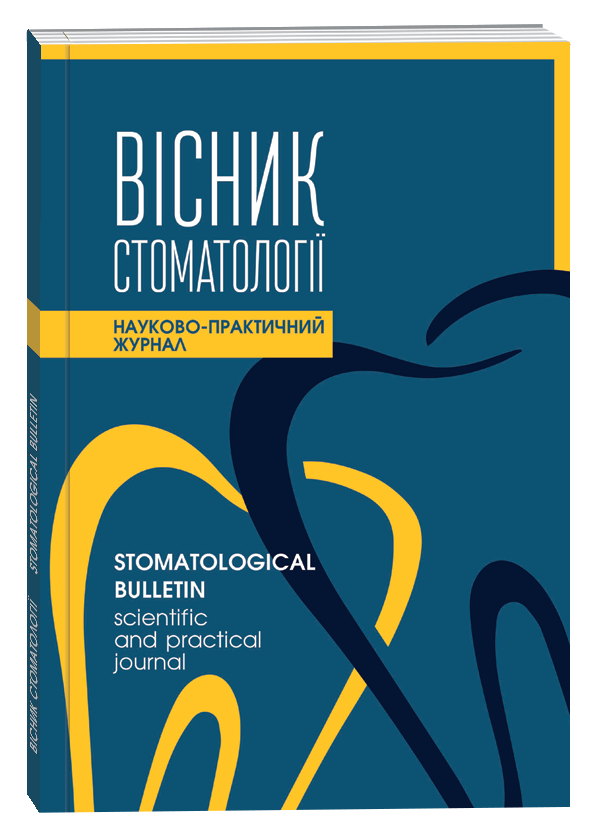EXPERIMENTAL SIMULATION STUDY OF TITANIUM PLATES FOR THE SELECTION OF TREATMENT TACTICS IN OPEN FRACTURE OF THE LOWER JAW WITH THE PRESENCE OF A TOOTH IN THE FRACTURE CLEFT
DOI:
https://doi.org/10.35220/2078-8916-2023-47-1.17Keywords:
titanium plate, determination of mechanical parameters of the bone, fractures of the lower jaw, tooth in the fracture gap, diastasis of the bone wound, immobilization of fragments of the lower jaw.Abstract
The aim. Determine the hardness and elasticity of titanium plates to bone tissue and improve the effectiveness of treatment of patients with open fractures of the lower jaw with the presence of a tooth in the fracture gap. Materials and methods. X-ray examination methods (computed tomography). 60 patients were examined and treated. Surgical treatment took place for 6 months on the basis of KMKL No. 12, ShCLV No. 2 in Kyiv from 02.01.2022 to 08.01.2022. There were 40 men and 20 women among the patients of all groups. The age of the patients ranged from 18 to 60. I group 20 – a unilateral fracture of the angle of the lower jaw that passes transversely through the socket of the tooth, characterized by the location of the fracture plane approximately along the entire line and through the apex of the root. II group 20 – one-sided fracture of the angle of the lower jaw, which passes obliquely through the tooth socket. III group 20 – unilateral fracture of the angle of the lower jaw tangential to the tooth socket. Scientific novelty. determination of the optimal area of the bone, for applying bone fixators using a device for determining the mechanical parameters of the bone No. 150086 dated 12.30.2021. Improving the efficiency of tooth fixation in the fracture gap. Conclusions. The basis of success is the choice of a titanium plate to achieve the minimum diastasis of the bone wound and alignment of fragments, which allows to make the bite as natural as possible in the future and to restore it. The distance of the screws closest to the fracture gap was taken into account in the model, which improved the fixation of the plate on the lower jaw. Thus, with a sufficiently precise alignment of the fragments and the presence of a tight contact between them, the 1.5 mm plate was able to provide stability to the conditions corresponding to chewing. In the presence of diastasis between the fragments of the cranium, one plate of this form provides sufficient stability under masticatory loads in the presence of 5 self-tapping screws. One of the important factors remains the peculiarities of the biomechanical behavior of the "Lower jaw-plate" system in this case determined by the presence of a contact zone of bone fragments, which allows us to directly perceive part of the load and, due to this, to unload the plate in the fracture area. After repositioning and immobilization of fragments of the lower jaw, it is necessary to create conditions for the processes of reparative osteogenesis.
References
Авєтіков Д.С. Застосування математичної моделі розтягнення і релаксації шкірно-жирових клаптів голови при їх підйомі та мобілізації. Проблеми екології та медицини. 2011. Том 15. -№ 3-4. С. 56.
Хекманн З.М., Лінке Й.Й., Вінтер В., Вебер Х.П. Біомеханіка покривних протезів з опорою на імплантати. Новини стоматології. 2003. № 2. C. 9-14.
Чуйко А.Н., Бережная Е.О., Бочаров Э.В., Бахуринский Н.Ю. О роли современных возможностей биомеханического анализа в стоматологии. Вісник стоматології. 2001. № 3. С. 43-49.
Panagiotopoulou O. Finite element analysis (FEA): applying an engineering method to functional morphology in anthropology and human biology. Ann. Hum. Biol. 2009. Vol.36. № 5. Р. 609-623.
Ступницький Р.М. Морфометрична будова гаверсових каналів альвеолярного відростка нижньої щелепи залежно від віку. Український стоматологічний альманах. 2006. № 2. С. 19-21.
Чуйко А.Н., Шинчуковский И.А. Биомеханика в стоматологии. Харьков: Форт, 2010. – 466 с.
Al-Sukhun J., Lindqvist C., Helendius M. Development of a three-dimensional finite element model of a human mandible containing endosseous dental implants II. Variables affecting the predictive behavior of a finite element model of a human mandible. J Biomed Mater Res A. 2007. vol. 80 (1). Р. 247-256 doi: 10.1002/ jbm.a.30894.
Hara T., Takizawa M., Sato T., Ide Y. Mechanical properties of buccal compact bone of the mandibular ramus in human adults and children: relationship of the elastic modulus to the direction of the osteon and the porosity ratio. Bull Tokyo Dent Coll. – 1998. Vol.39 (1). P.47-55.
Harle F., Champy M., Terry B. Atlas of Craniomaxillofacial Osteosynthesis. Miniplates, Mocroplates, and Screws. Stuttgart, New York: Thieme, 1999. 182 p.
Mish C.E., Qu Z., Bidez M.W. Mechanical properties of trabecular bone in the human mandible: implications for dental implant treatment planning and surgical placement. J Oral Maxiollofac Surg. 2000. Vol. 58(2). P247-248.
Sahin S., Cehreli M.C., Yalcin E. The influence of functional forces on the biomechanics of implant-supported prostheses-a review. J. Dent. 2002. № 30. Р.271-282.
Schwartz-Dabney C.L., Dechow P.C. Edentulation alters material properties of cortical bone in the human mandible. J Dent Res. 2002. Vol.81(9). P.613-617.
Schonning A., Oommen B., Ionescu I., Conway T. Hexahedral mesh development of free-formed geometry: The human femur exemplified. Computer-Aided Design. 2009. Vol.41. № 8. Р. 566-572.
Yamamoto K., Matsusue Y., Murakami K., Horita S., Sugiura T., Kirita T. Maxillofacial fractures in older patients. J Oral Maxillofac Surg. 2011. Vol. 69 (8). P. 2204 -2210.
Спосіб вимірювання щільності кісткової тканини : пат.5839 UA, МПК A 61 B 6/14. № 20040907367; заявл. 08.09.2004; опубл.15.03.2005.
Rho J.Y., Ashman R.B., Turner C.H. Young's modulus of trabecular and cortical bone material: ultrasonic and microtensile measurements. J. Biomech. 1993. № 26. Р.111-119.
Sheng-Hui L., Ruo-Feng T., Jin-Xiang D. Anisotropic finite element modeling for patient-specific mandible. Computer Methods and Programs in Biomedicine. 2007. Vol. 8(3). P. 197-209.









